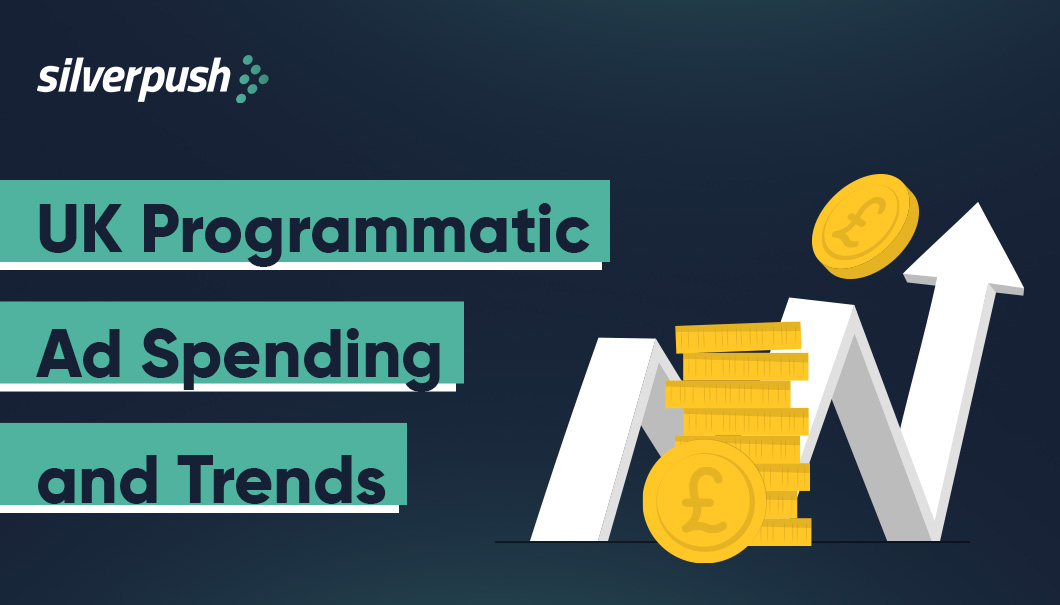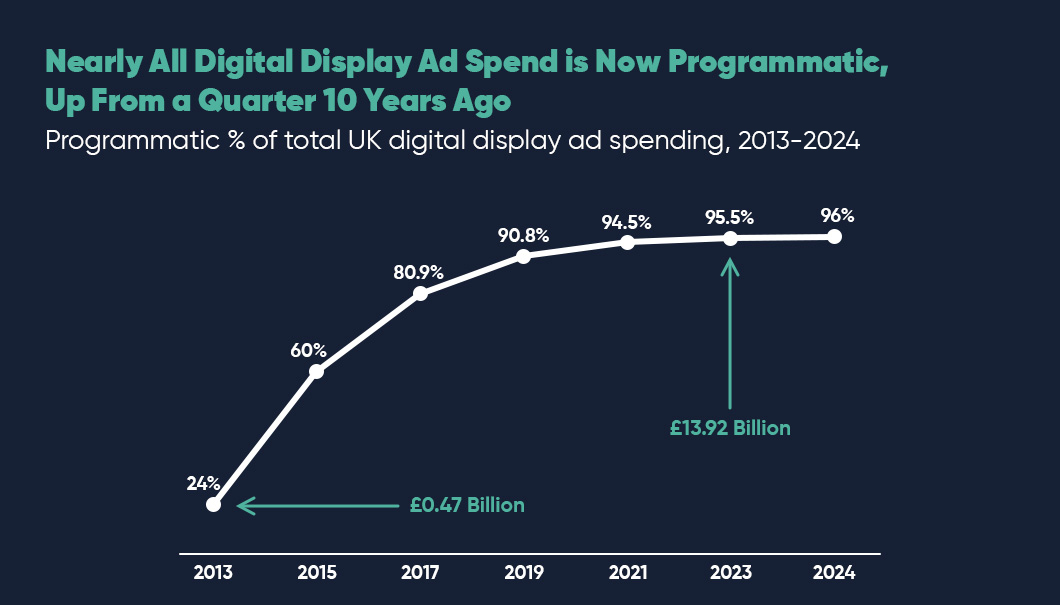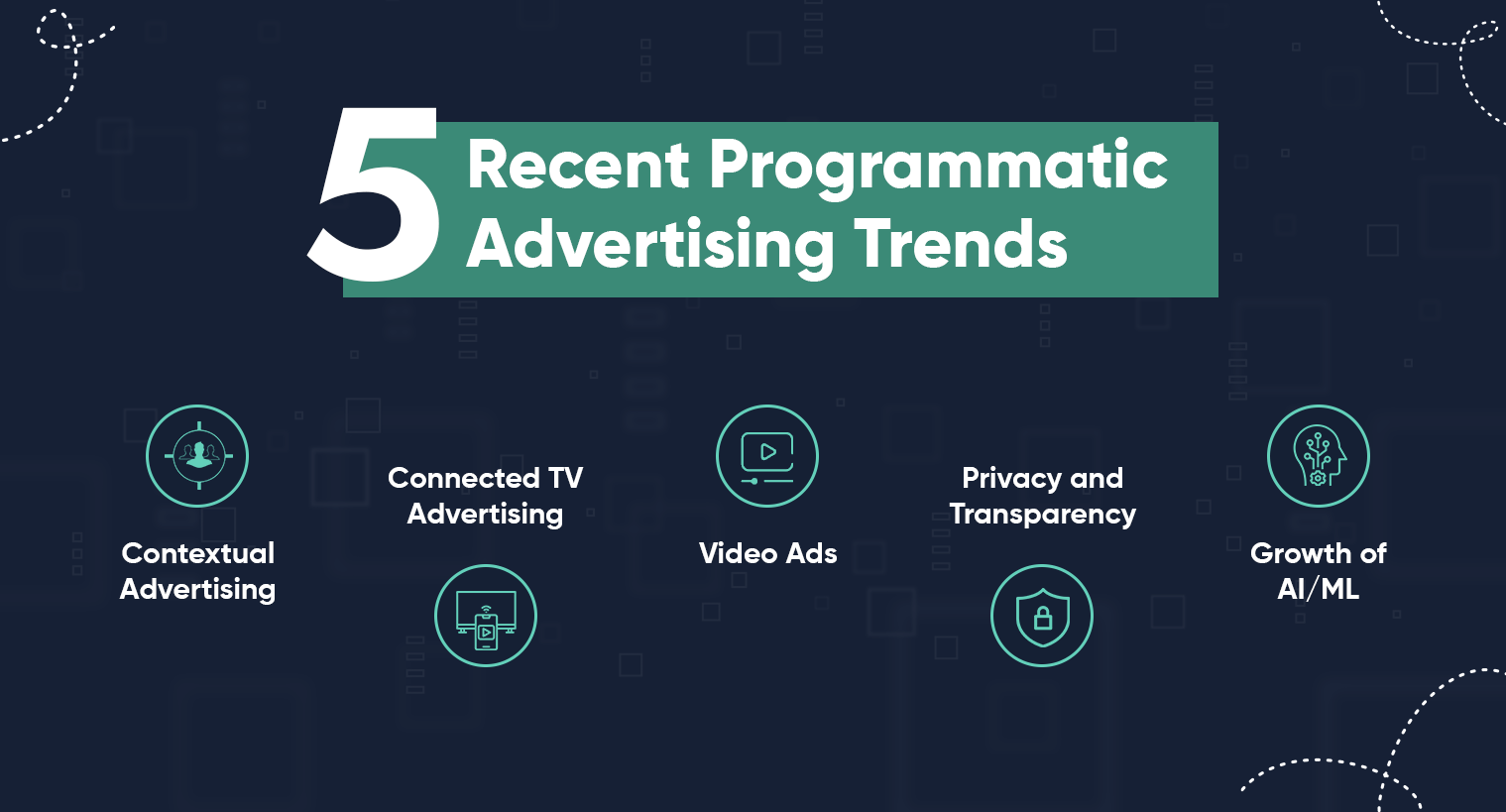UK Programmatic Advertising Spending & Trends in 2024
PUBLISH DATE: 18 June 2024
In 2023, programmatic advertising spending in the UK reached roughly £30.6 billion. The programmatic display advertising market is projected to grow by 12.6% in 2024, bringing it to within just four percentage points of becoming fully programmatic. This highlights how integral this technology has become to the UK ad industry. On the other hand, mobile programmatic ad spending increased at a similar rate of 12.7%. However, Connected TV (CTV) advertising is expected to outperform both, growing by 20.7%, which is 8 percentage points higher.
Programmatic is dominating the market. More than four out of every five (85%) British pounds is conducted programmatically, and this proportion is projected to grow in the coming years. This trend holds substantial global importance.

What is Programmatic Advertising?
Programmatic advertising refers to the automated buying and selling of online advertising space, utilizing software and algorithms to facilitate the process. Unlike manual advertising, which depends on negotiation between publishers and marketers, programmatic buying leverages technology to purchase ad space efficiently.
The UK, being one of the largest digital ad markets worldwide, boasts a high programmatic uptake, making it the third-largest programmatic ad market globally. With programmatic ad revenues reaching approximately 38 billion USD in 2023, the British market is surpassed only by the United States and China.
Here are the key aspects of programmatic advertising:
- Automation: Unlike traditional ad buying, which involves manual processes and negotiations, programmatic advertising uses automated systems to purchase ad space. This makes the process faster and more efficient.
- Real-time Bidding (RTB): One of the most common forms of programmatic advertising is real-time bidding. In RTB, ad impressions are bought and sold in real-time auctions that occur in milliseconds before a webpage load for a user. This allows advertisers to bid for ad space based on the user’s profile and the likelihood of the ad’s success.
- Data-driven: Programmatic display advertising relies heavily on audience data to target ads. Advertisers use data from various sources, including user demographics, behavior, and interests, to ensure their ads reach the right audience at the right time.
Notable Key Trends in Programmatic Advertising in 2024
1. CTV Advertising
CTV is becoming one of the main focal points for UK media buyers. A global survey indicated that 85 percent of marketers expect to increase their CTV ad spend in 2024 as viewers switch from cable and satellite to over-the-top (OTT) video content. (Source: Statista)
2. Advanced Integrated AI and Machine Learning Support
The integration of advanced AI & ML is transforming the programmatic ads industry, redefining the conception & inclusion of Ad campaigns. These cutting-edge technologies can now analyze vast quantities of data with remarkable speed and accuracy, significantly enhancing advertiser’s ability to comprehend & predict consumer behavior. With the capabilities of AI & ML, advertisers are able to optimize their campaigns dynamically. Through this process, the delivery of highly targeted & personally relevant advertising experiences is possible for every consumer.
3. Cookieless Advertising
Among the evolving trends in programmatic advertising, the shift away from cookies is particularly unpredictable. Google’s planned discontinuation of cookie support has been a topic for years. Initially set for the second quarter of 2022, it was delayed to 2023, and now it has been postponed again to 2025, giving advertisers more time to adapt.
Third-party cookies play a crucial role in various advertising functions such as targeting, frequency capping, measurement, and attribution. With the impending phase-out of cookie support by Google and other platforms, alternative solutions are necessary.
Proprietary data offers a wealth of valuable insights for advertisers, including user preferences and purchasing patterns. This data opens up numerous possibilities and can be leveraged in several ways, such as:
- Expanding the scope of user data.
- Addressing registration obstacles.
- Enhancing audience segmentation and contextual targeting.
4. Programmatic Digital Out-Of-Home Will Reach New Heights
In 2024, programmatic digital-out-of-home (pDOOH) advertising is expected to grow significantly. Spending on pDOOH ads is projected to increase by 57% from 2023 to 2028, reaching $15.53 billion. This growth shows how effective and innovative pDOOH advertising has become. Most marketers trust pDOOH because it provides a safe environment for brand messages. Two out of three marketers believe it ensures brand safety. Brands that can make memorable and eye-catching ads for pDOOH will benefit the most. These ads should be personalized, interactive, and immersive to attract and engage audiences effectively.
5. Various Forms of Advertising in the Programmatic World
In 2024, the integration of AI in creative optimization will become more prominent. Artificial Intelligence tools will leverage data to tailor ad creatives in real time, ensuring that users see the most relevant and engaging formats. Expect to see a rise in video formats and in-app ads, providing a direct connection to customers during their most engaged moments. Dynamic creatives will elevate personalization to new heights, adapting ad content in real time based on user behavior and preferences. This innovation has the potential to revolutionize conversion rates.
Ready to integrate the latest UK programmatic advertising trends into your 2024 marketing strategy? In the UK, programmatic digital display ad spending will account for 96.0% of the overall digital display market this year, highlighting its dominance in sectors like e-commerce. Innovations such as cookieless marketing, personalization, and AI-powered solutions are transforming how businesses market and convert customers. To achieve your business goals and leverage these new technologies, connect with us now!
The Rise of Programmatic Advertising: Top 5 Trends Shaping the Industry
PUBLISH DATE: 28 February 2023
Want to know where programmatic advertising is headed? Check out the blog which talks about the top 5 programmatic advertising trends to keep an eye on, including the rise of connected TV, the importance of privacy and transparency, and more.
Programmatic advertising has revolutionized the world of digital marketing by utilizing automation to buy and sell digital ad space. This approach has replaced the traditional manual process that relied on human interaction and negotiation between publishers and marketers.
The use of data-driven strategies has enabled programmatic advertising to streamline and accelerate ad buying processes, resulting in increased campaign efficiency.
Recent estimates indicate that programmatic advertising generated 418 billion U.S. dollars in 2021 and is projected to reach 725 billion by 2026. Given these impressive figures, it’s natural to wonder if programmatic advertising is the future of advertising.
To answer this question and stay up-to-date with the latest trends, let’s take a closer look at the new trends in programmatic advertising.
5 Recent Programmatic Advertising Trends

1. Contextual Advertising Stands Strong
Contextual targeting is a straightforward yet powerful method of advertising that continues to be a key programmatic trend to watch, particularly in light of the decline of cookies. In digital advertising, contextual targeting is becoming increasingly important as ads are placed based on the context of the website, rather than relying on a user’s online behavioral data.
With contextual targeting, advertisers can reasonably assume that those who see their ads are more likely to be interested in them due to the web page’s context. As users have grown weary of seeing irrelevant ad creatives in inappropriate locations, banner blindness has become more prevalent. To address this, advertisers must enhance the ad experience by using personalized and relevant ads in the right context, thereby improving engagement and driving better results.
Also read: https://www.silverpush.co/blogs/what-is-programmatic-advertising/
2. Connected TV Advertising Continues to Grow
Connected TV usage among millennials is expected to grow from 60.5 million monthly users in 2022 to 62.6 million by 2025.
Prior to Covid, 76% of U.S. households had at least one connected device, with a total of 12.5 billion use hours per month. Following the pandemic, this figure increased by 81%, resulting in 4 billion hours of CTV use every week.
As a result, buyers are planning to allocate more of their advertising budget to CTV in 2023, with IAB reporting that ad spend is being reallocated from broadcast (53%) and cable TV (52%) advertising to CTV.
This makes CTV one of the most intriguing programmatic advertising trends to watch in 2023. Advertisers must pay close attention to the procurement process, methods, and measurements that need to be reevaluated in response to this trend. Although CTV advertising is still in its early stages, those who adapt and stay ahead of the curve will benefit from the rewards.
3. Video Ads
The popularity of video content continues to soar, with video consumption expected to account for 82% of consumer internet traffic this year. As a result, video ad spending is projected to increase year after year. In 2021, programmatic video advertising spending in the United States reached an estimated 52.17 billion U.S. dollars, and this figure is expected to grow even further to reach 74.88 billion dollars by the end of 2023.
Notably, video advertising is considered to be the most impactful format for high-impact display ads, contributing to the growth in programmatic video spend. Given that programmatic video spending is expected to represent the majority of total programmatic digital display spending in the US this year, it’s clear that automated video ad buying has become the standard approach for distributing digital video commercials.
4. Growing Need for Privacy and Transparency
As privacy and transparency become top priorities, marketers must adapt to a world without third-party data. With the rise of new privacy laws like GDPR and the California Privacy Act, traditional tracking methods are no longer viable. While advertisers can still obtain user data with their consent, relying solely on tracking cookies to target and personalize ads is no longer an option. The recent moves by Apple, Firefox, and Google to end third-party cookie support further emphasize the need for innovative and reliable workarounds in programmatic advertising. At this critical juncture, it’s time for marketers to prioritize transparency and build trust with their audiences by adopting new, privacy-first strategies.
5. Use of AI/ML Rapidly Expands
The rise of Artificial Intelligence and Machine Learning (AI/ML) is revolutionizing programmatic advertising by enhancing targeting, optimization, and prediction capabilities. By leveraging AI algorithms, brands can now automate and optimize their ad-buying process to ensure that their messages reach the right people at the right time.
As AI and ML technologies continue to advance, programmatic advertising platforms are incorporating these tools to improve ad targeting, creative optimization, and budget allocation in real time. With AI/ML-driven automation, brands can create personalized experiences for each customer, as seen in Overstock’s successful implementation of AI for individualized customer experiences. The increasing use of AI/ML in programmatic advertising is paving the way for more efficient and effective ad campaigns, providing brands with a competitive edge in the digital marketing landscape.
Conclusion
Programmatic advertising is an ever-evolving field that requires constant attention and adaptation to stay ahead of the curve. From the growing need for privacy and transparency to the increasing use of AI and Machine Learning technologies, these five programmatic advertising trends are transforming the digital advertising landscape. As programmatic advertising continues to evolve, it’s crucial for brands to stay up-to-date on the latest trends and developments. By doing so, they can ensure that their advertising campaigns remain relevant, engaging, and effective in today’s rapidly changing digital marketing landscape.







